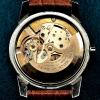-
Recently Browsing
- No registered users viewing this page.
-
Topics
-
Posts
-
All I do is use a fine marker (sharpie) to put the service date on the back cover, this way it can be removed with some IPA and does no permanent damage to the watch. I'm in two minds about the whole service marking thing, sometimes it's good/bad to see the markings on the watch case back as you know it's been worked on and vice versa. However, if I took my car in for a service and the mechanic scratched some code into the housing of my engine I wouldn't be too impressed. Hence, I think my sharpie solution is a reasonable compromise.
-
hmmmm.... maybe there is a way to skin that cat 🙀 let me think on it... unless anyone else has any ideas? I left the opening in the side of the base and ring quite large to maybe allow you to grip the crown, but appreciate this may not always be possible, especially for small movements where the crown will not extend past the outer wall of the holder. I noticed this also, but after using the holder for a while I noticed that the ring/holder began to wear into shape (rough edges/bumps worn off) and the size became closer to the desired movement OD. Maybe with some trial and error we could add 0.5 mm (??) to the movement OD to allow for this initial bedding-in?
-
Hi nickelsilver, thanks for the great explanation and the links! I'll take a good look in the article. Especially this is great news to hear! Looking through forums and youtube videos I was informed to 'fist find a case and then fit a movement for it'. But seems that's not the case for pocket watches at least? I guess I should be looking to find some 'male square bench keys' for now. I was thinking of winding the mainspring using a screwdriver directly, but I found a thread that you've replied on, saying that it could damage the spring.
-
Murks, The rate and amplitude look OK, and the amplitude should improve once the oils you have used get a chance to move bed-in, also I notice that you are using default 52 degrees for the lift angle, if you get the real lift angle (assuming it's not actually 52) this will change your amplitude - maybe higher, maybe lower. I notice that the beat error is a little high, but not crazy high. At the risk of upsetting the purists, if the balance has an adjustment arm I would go ahead and try and get this <0.3 ms, but if it does not have an adjustable arm then I would probably leave well alone. Just my opinion.
-








Recommended Posts
Join the conversation
You can post now and register later. If you have an account, sign in now to post with your account.
Note: Your post will require moderator approval before it will be visible.